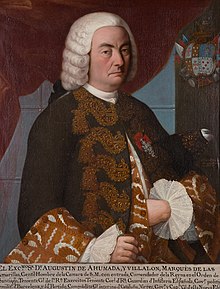Agustín Ahumada y Villalón
Agustín de Ahumada y Villalón , Margrave (Spanish: marqués) of las Amarillas , (* around 1710 in Ronda , Province of Andalusia , Spain ; † February 5, 1760 in Mexico City ) was a Spanish officer and colonial administrator who served as Viceroy of New Spain officiated.
Origin and family
Pedro Cebrián came from a family of Spanish nobility. His father was Bartolomé Félix de Ahumada y Ahumada, his mother's name was Luisa Gertrudis Fernández de Villalón y Narvaez. He married Luisa María de Ahumada y Vera, with whom he had at least one son, who was born in 1733.
Military career in Europe
Agustín de Ahumada entered the service of the Spanish army and distinguished himself in campaigns in Italy.
He reached the rank of lieutenant general in the regiment of the Royal Spanish Guard and was appointed governor of Barcelona. Ahumada was inducted into the Order of Santiago as an officer and the king created for him the title of Marquis of las Amarillas.
Tenure as Viceroy of New Spain
In May 1755 Ahumada was by King Ferdinand VI. appointed Viceroy of New Spain. In September 1755 he landed in Veracruz from Cádiz . He met his predecessor in office, Juan Francisco de Güemes y Horcasitas , in Otumba and moved into Mexico City on November 10th.
In 1756 he regulated the church administration in Puebla , which until then had granted licenses for gambling and distilling liquor to dubious personalities. At the end of 1756, the colony celebrated the recognition of the Madonna of Guadalupe as the official patron saint of Mexico.
In 1757 there was another uprising of the Comanche in Texas .
In 1758, a new volcano erupted in Michoacán on the site of a hacienda , which forced the relocation of villages and farms. Ahumada paid for a large part of the cost of the relocation out of his own pocket.
Ahumada let work on the drainage system for the Valley of Mexico continue. He promoted mining and sent a visitador to Bolaños (Jalisco) , where newly discovered silver deposits led to disputes over mining rights.
Even if the economic boom increased the income for the crown, the transport to Spain remained a dangerous undertaking, as pirates , especially from England , repeatedly attacked the Spanish ships.
In terms of foreign policy, Viceroy Ahumada also had to secure the borders of the colony, which was repeatedly harassed by British attempts to settle in Campeche and Belize as well as by French attempts to expand from Louisiana .
In 1759 King Ferdinand VI died, and Charles III. became his successor. By the time this news reached Mexico, the viceroy's health had deteriorated significantly.
After a stroke , he went to Cuernavaca for a cure on the advice of his doctors . The proclamation of the new king forced him to return to Mexico City, where he died on February 5, 1760.
He had spent all his fortune on charity and left his family in poverty so that the treasury had to pay for their return trip to Europe.
Until his successor Francisco Cajigal de la Vega arrived from Cuba in April 1760, the Real Audiencia of Mexico temporarily took over the affairs of state.
literature
- Juana Vázquez Gómez: Dictionary of Mexican Rulers, 1325–1997 . Greenwood Publishing Group, Westport CT 1997, ISBN 0-313-30049-6 , pp. 41 ( Google Books ).
- Fernando Orozco: Gobernantes de México . 3. Edition. Panorama Editorial, Mexico City 2004, ISBN 968-38-0260-5 , p. 139-140 ( Google Books ).
Web links
- Biography (spanish)
- Biography (spanish)
- History of his tenure (Spanish)
| predecessor | Office | successor |
|---|---|---|
| Juan Francisco de Güemes y Horcasitas |
Viceroy of New Spain 1755–1760 |
Francisco Cajigal de la Vega |
| personal data | |
|---|---|
| SURNAME | Ahumada y Villalón, Agustín |
| ALTERNATIVE NAMES | Ahumada y Villalón, Agustín de (full name); Ahumada y Margrave, Agustín; Las Amarillas, from |
| BRIEF DESCRIPTION | Spanish officer and colonial administrator |
| DATE OF BIRTH | around 1710 |
| PLACE OF BIRTH | Ronda , Andalusia Province , Spain |
| DATE OF DEATH | February 5, 1760 |
| Place of death | Mexico city |
